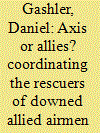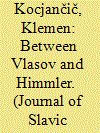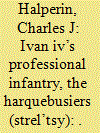|
|
|
Sort Order |
|
|
|
Items / Page
|
|
|
|
|
|
|
| Srl | Item |
| 1 |
ID:
152226


|
|
|
|
|
| Summary/Abstract |
During World War II, American Army Air Forces commanders cooperated with Communist Partisans and their Chetnik enemies to rescue thousands of downed airmen from occupied Yugoslavia. American intelligence realized that a British-exclusive alliance with the Partisans hampered the ability to rescue as many airmen as possible. US commanders were unwilling to divert significant resources to the Balkans but instead gambled that the Chetniks might be willing to cooperate with rescuers as well. Air Force commanders were involved just enough to ensure that hundreds evaded capture, without involving themselves in a conflict where Americans had no national interest. These commanders showed the value of pragmatic cooperation over grand, ideological alliance.
|
|
|
|
|
|
|
|
|
|
|
|
|
|
|
|
| 2 |
ID:
152223


|
|
|
|
|
| Summary/Abstract |
The aim of the article is to present the little-known Russian (Soviet) military unit that fought on the German side during the Second World War. Origins of this regiment go back to the Wrangel’s émigré army in the Kingdom of Yugoslavia, which provided the cadre for the future unit, working for the Germans against their old enemy — communists. First established as auxiliary police in Serbia, personnel were then sent to the Eastern front to perform commando-style actions in the Soviet hinterland. With the collapse of the German might, this unit was sent to Slovenia, reformed as a regiment, and used in warfare against local partisans.
|
|
|
|
|
|
|
|
|
|
|
|
|
|
|
|
| 3 |
ID:
152220


|
|
|
|
|
| Summary/Abstract |
The West’s approach to Russian machinations in the Arctic is too often misinformed by simplistic media storylines of militarization and zero-sum competition. While Russian behavior of late in Ukraine and Syria has hardly been reassuring, Moscow’s Arctic approach stands remarkably separate from the larger tumult of relations with the West. The prevailing focus on security enhancements across Russia’s Arctic coastline risks oversimplifying Kremlin decision calculus and distorting conflict potential. Fortunately, recent trends in the region provide greater contextualization concerning Russian security. This article examines six features of Russia’s Arctic strategy that are particularly significant when considering an effective Western counter-posture in the Arctic. Three act to mitigate the risk of confrontation, while three other factors hold the potential to aggravate the security environment, After setting the geopolitical scene with these six features, this article offers five policy suggestions for the four NATO Arctic rim states. It argues against a blunt force deterrence posture in favor of a more nuanced approach based on issue-specific cooperation so as not to unnecessarily drag the region into a larger geopolitical fight.
|
|
|
|
|
|
|
|
|
|
|
|
|
|
|
|
| 4 |
ID:
152225


|
|
|
|
|
| Summary/Abstract |
The myth of the German mechanical juggernaut crushing a medieval Polish army has been repeatedly deconstructed. Elements of the myth are prima facie false, and others seen at first blush as factual are, with closer reading, products of propaganda, faulty intelligence, or intellectual prejudice. Soldiers rely on the victor’s delusion to keep their morale high, and wartime statesmen use mythos and delusion to shift blame, explain away inaction, and keep the public committed to final victory. Historians have no need of the myth, yet they perpetuate the meme and accept a simplistic version of events over a far more complex actuality. This article reexamines the myth using new research, examines why historians succumb to the romance of the myth, and critiques the implicit ramifications for the historical discipline.
|
|
|
|
|
|
|
|
|
|
|
|
|
|
|
|
| 5 |
ID:
152227


|
|
|
|
|
| Summary/Abstract |
The early modern European Military or Gunpowder Revolution did not exclude Muscovy, although the chronology and extent of its impact on Muscovy varied from Western Europe. This article examines the first step in that process, the creation of a standing army of gunpowder infantry, the harquebusiers (strel’tsy). It attempts to measure the influence of this development by determining the number of harquebusiers who served during Ivan’s reign. Previous studies of this question have overlooked the most detailed available data in the military registers for Ivan’s 1577 campaign in Livonia. Although it is impossible to compute an exact number, analysis leads to the conclusion that a field army could contain between 5,000 and 7,000 harquebusiers, which might constitute as much as 20 percent of the troops. However, this total does not include un-mobilized garrison harquebusiers, whose number remains unknown. The creation of the harquebusiers reflects a strategic decision to establish and increase professional gunpowder infantry, a reflection of the Military Revolution.
|
|
|
|
|
|
|
|
|
|
|
|
|
|
|
|
| 6 |
ID:
152219


|
|
|
|
|
| Summary/Abstract |
Comparing the influence of and relationship of Central Asia with the major regional bodies, the SCO is an advantageous organization for the economic development of Central Asia, since it is an opportune podium for doing business, especially with China, with a guarantee that Moscow nor Beijing will take a dominating stance against them. Due to a lack of armed forces among CSTO allies, Russia delivers the majority of the troops assigned under the banner of the CSTO. However, this also means that the Kremlin — in return for its security umbrella — demands a certain degree of political influence on the Central Asian member states of the CSTO. The less Central Asian countries are depending on Russia for political, economic/energy, or security reasons, the more they can pursue their national interests.
|
|
|
|
|
|
|
|
|
|
|
|
|
|
|
|
| 7 |
ID:
152222


|
|
|
|
|
| Summary/Abstract |
This article examines the military change that has taken place in Ukraine since the conflict in the east began in 2014 and argues that the Ukrainian military that is emerging from this process is very different from that envisaged by earlier governments. The realities of the conflict on Ukraine from 2014 onwards have necessitated a move away from the transformational model of military reform adopted from 2006 to 2014. Instead, the Ukrainian Armed Forces (UAF) have been forced to adapt their structure, means, and methods according to a complex blend of the resuscitation of older features and the embrace of new solutions. This process notably has included the adoption of mass, crowdfunding, and the raising of volunteer battalions. These changes provide the foundation for what is likely to continue to be a painful process of far-reaching military reform.
|
|
|
|
|
|
|
|
|
|
|
|
|
|
|
|
|
|
|
|
|